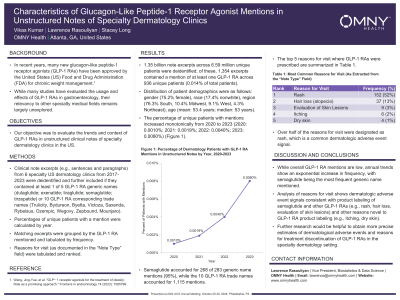Monday Poster Session
Category: Obesity
P3171 - Characteristics of Glucagon-Like Peptide-1 Receptor Agonist Mentions in Unstructured Notes of Specialty Dermatology Clinics
Monday, October 28, 2024
10:30 AM - 4:00 PM ET
Location: Exhibit Hall E

Has Audio

Lawrence Rasouliyan, MPH
OMNY Health
Atlanta, GA
Presenting Author(s)
Vikas Kumar, MSc, MD, Lawrence Rasouliyan, MPH, Stacey Long, MS
OMNY Health, Atlanta, GA
Introduction: In recent years, many new Glucagon-Like Peptide-1 receptor agonists (GLP-1 RAs) have been approved by the US Food and Drug Administration for chronic weight management. While many studies have evaluated the usage and effects of GLP-1 RAs in gastroenterology, their relevancy to other specialty medical fields remains largely unexplored. Our objective was to evaluate the trends and context of GLP-1 RAs in unstructured notes of specialty dermatology clinics.
Methods: Clinical note excerpts (e.g. sentences and paragraphs) from six specialty US dermatology clinics from 2017-2023 were deidentified and further included if they contained at least one of 5 GLP-1 RA generic names (dulaglutide; exenatide; liraglutide; semaglutide; tirzepatide) or 10 GLP-1 RA corresponding trade names. Percentages of unique patients with a mention were calculated by year. Matching excerpts were grouped by the GLP-1 RA mentioned and tabulated by frequency. Reasons for visit (as documented in the “Note Type” field) were tabulated and ranked.
Results: 1.35 billion note excerpts across 6.59 million unique patients were deidentified; of these, 1,354 excerpts contained a mention of at least one GLP-1 RA across 936 unique patients (0.014 % of total patients). The percentage of unique patients with mentions increased exponentially from 2020 to 2023 (2020: 0.0010%; 2021: 0.0019%; 2022: 0.0040%; 2023: 0.0080%). Semaglutide accounted for 268 of 283 generic name mentions (95%), while the 10 GLP-1 RA trade names accounted for 1,115 mentions. 293 of the 1,354 excerpts (22%) contained a reason for visit in the “Note Type” field; the five most common reasons for visit were rash (152; 52%), hair loss (37; 13%), evaluation of skin lesions (9; 3%), itching (6; 2%), and dry skin (4; 1%).
Discussion: While overall GLP-1 RA mentions are low, annual trends show an exponential increase in frequency, with semaglutide being the most frequent generic name mentioned. Analysis of reasons for visit shows dermatologic adverse events consistent with product labeling of semaglutide and other GLP-1 RAs (e.g. rash, hair loss, evaluation of skin lesions) as well as some that may be novel to product labeling of GLP-1 RAs (e.g. itching, dry skin). Further research would be helpful to obtain more precise estimates of dermatological adverse events and reasons for treatment discontinuation of GLP-1 RAs in the specialty dermatology setting.
Disclosures:
Vikas Kumar, MSc, MD, Lawrence Rasouliyan, MPH, Stacey Long, MS. P3171 - Characteristics of Glucagon-Like Peptide-1 Receptor Agonist Mentions in Unstructured Notes of Specialty Dermatology Clinics, ACG 2024 Annual Scientific Meeting Abstracts. Philadelphia, PA: American College of Gastroenterology.
OMNY Health, Atlanta, GA
Introduction: In recent years, many new Glucagon-Like Peptide-1 receptor agonists (GLP-1 RAs) have been approved by the US Food and Drug Administration for chronic weight management. While many studies have evaluated the usage and effects of GLP-1 RAs in gastroenterology, their relevancy to other specialty medical fields remains largely unexplored. Our objective was to evaluate the trends and context of GLP-1 RAs in unstructured notes of specialty dermatology clinics.
Methods: Clinical note excerpts (e.g. sentences and paragraphs) from six specialty US dermatology clinics from 2017-2023 were deidentified and further included if they contained at least one of 5 GLP-1 RA generic names (dulaglutide; exenatide; liraglutide; semaglutide; tirzepatide) or 10 GLP-1 RA corresponding trade names. Percentages of unique patients with a mention were calculated by year. Matching excerpts were grouped by the GLP-1 RA mentioned and tabulated by frequency. Reasons for visit (as documented in the “Note Type” field) were tabulated and ranked.
Results: 1.35 billion note excerpts across 6.59 million unique patients were deidentified; of these, 1,354 excerpts contained a mention of at least one GLP-1 RA across 936 unique patients (0.014 % of total patients). The percentage of unique patients with mentions increased exponentially from 2020 to 2023 (2020: 0.0010%; 2021: 0.0019%; 2022: 0.0040%; 2023: 0.0080%). Semaglutide accounted for 268 of 283 generic name mentions (95%), while the 10 GLP-1 RA trade names accounted for 1,115 mentions. 293 of the 1,354 excerpts (22%) contained a reason for visit in the “Note Type” field; the five most common reasons for visit were rash (152; 52%), hair loss (37; 13%), evaluation of skin lesions (9; 3%), itching (6; 2%), and dry skin (4; 1%).
Discussion: While overall GLP-1 RA mentions are low, annual trends show an exponential increase in frequency, with semaglutide being the most frequent generic name mentioned. Analysis of reasons for visit shows dermatologic adverse events consistent with product labeling of semaglutide and other GLP-1 RAs (e.g. rash, hair loss, evaluation of skin lesions) as well as some that may be novel to product labeling of GLP-1 RAs (e.g. itching, dry skin). Further research would be helpful to obtain more precise estimates of dermatological adverse events and reasons for treatment discontinuation of GLP-1 RAs in the specialty dermatology setting.
Disclosures:
Vikas Kumar indicated no relevant financial relationships.
Lawrence Rasouliyan indicated no relevant financial relationships.
Stacey Long indicated no relevant financial relationships.
Vikas Kumar, MSc, MD, Lawrence Rasouliyan, MPH, Stacey Long, MS. P3171 - Characteristics of Glucagon-Like Peptide-1 Receptor Agonist Mentions in Unstructured Notes of Specialty Dermatology Clinics, ACG 2024 Annual Scientific Meeting Abstracts. Philadelphia, PA: American College of Gastroenterology.
